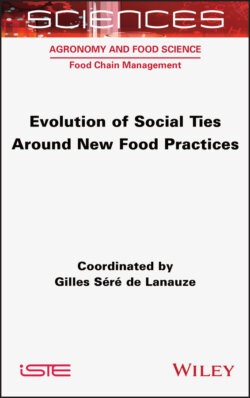Читать книгу Evolution of Social Ties around New Food Practices - Группа авторов - Страница 20
1.3.1. Benefits of practice theories to the study of eating together
ОглавлениеPractice theories are a set of theories and concepts whose principle is understanding everyday and routine activities by studying the emergence of practices as a result of the context rather than by analyzing the choices made by individuals to arrive at a behavior. Schatzki, a founding author of this theoretical trend, inherited from the work of Bourdieu and Giddens, defines practices as sets of activities that involve and are linked by knowledge, skills, meanings and material elements (Schatzki 1997). Reckwitz, another seminal author, positions himself in relation to Schatzki’s ideas by adding the study of habits and routinized actions. Reckwitz (2002) defines practices as a type of routine behavior that consists of several interconnected elements: forms of bodily activities, mental activities, “things” and their use, accumulated knowledge in the form of understandings, skills, emotional states and motivational knowledge. Thus, social practices are taken as the unit of analysis; individuals are considered to be “carriers” of practices.
Shove et al. (2012), building on the seminal work of Reckwitz (2002), propose a simplified framework to empirically explain the emergence, maintenance and demise of practices. According to this framework, a practice emerges and is maintained as a result of a combination of three elements: skills, meanings and materials (Shove et al. 2012) (Figure 1.1).
Figure 1.1. Diagram of the conceptual framework from Shove et al. (2012), as presented in Spurling et al. (2013). For a color version of this figure, see www.iste.co.uk/seredelanauze/evolution.zip
“Skills” refer to what an individual needs to know in order for a practice to emerge and be sustained. Skills are also found, in a more abstract way, in the knowledge related to a practice. Thus, under the term “skills”, we can distinguish between physical abilities, know-how and knowledge.
The “material” element refers to what is tangible and mechanically or physically constrains or enables an action. This element groups objects and technologies (Reckwitz 2002; Shove and Pantzar 2005; Warde 2005) with infrastructure (Hargreaves 2011).
“Meanings” refers to “the social and symbolic significance of participating [in an action] at any given time” (Shove et al. 2012). This notion can be translated into the concept of the teleoaffective structure described by Schatzki (2005, pp. 42–55) or in terms of purpose and emotion, a form of goal-oriented engagement (Warde 2005).
Practice theories have been used to understand the emergence or to accompany the implementation of more sustainable practices (e.g. Hand et al. (2005), who study the evolution of hygiene practices and Gram-Hanssen (2010) who studies heating practices in relation to energy savings). Practice theories can furthermore be used to understand the emergence, maintenance or disappearance of practices at different scales: at the scale of a society (e.g. Shove and Pantzar 2005), or at a more individual scale, to understand how a particular practice is implemented by a particular individual or household (e.g. the practice of recycling in households (Fournier-Schill 2014)). Our chapter opts for this second approach in order to understand, at a micro level, what explains the existence and maintenance of the practice of eating together at the household level. The following section presents a qualitative study conducted for this purpose.
